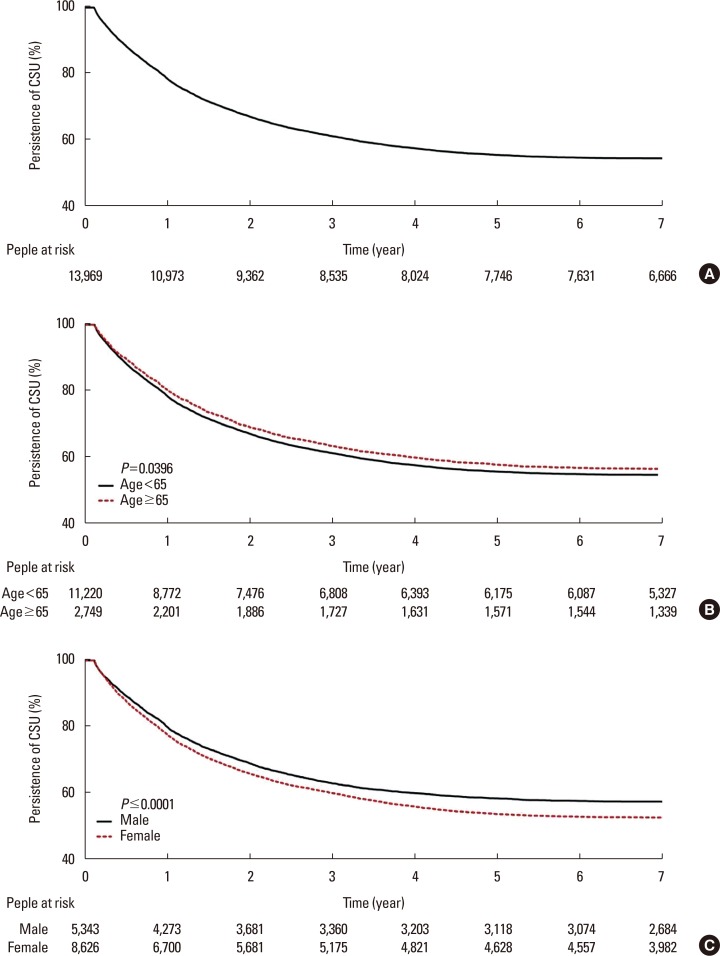Allergy Asthma Immunol Res.
2018 Jan;10(1):83-87. 10.4168/aair.2018.10.1.83.
Clinical Course of Chronic Spontaneous Urticaria in the Korean Adult Population
- Affiliations
-
- 1Department of Dermatology, The Catholic University of Korea College of Medicine, Seoul, Korea. yymmpark6301@hotmail.com
- 2Department of Medical Statistics, The Catholic University of Korea College of Medicine, Seoul, Korea.
- 3Department of Dermatology, Kyung Hee University School of Medicine, Seoul, Korea.
- 4Department of Dermatology, Gachon University Gil Medical Center, Incheon, Korea.
- 5Department of Dermatology, Chung-Ang University College of Medicine, Seoul, Korea.
- 6Department of Dermatology, Korea University College of Medicine, Seoul, Korea.
- 7Department of Dermatology and Cutaneous Biology Research Institute, Yonsei University College of Medicine, Seoul, Korea.
- 8Department of Dermatology, University of Ulsan College of Medicine, Asan Medical Center, Seoul, Korea.
- KMID: 2428853
- DOI: http://doi.org/10.4168/aair.2018.10.1.83
Abstract
- Knowledge of the clinical course of chronic spontaneous urticaria (CSU) remains unclear. The purpose of our study was to investigate the clinical course of CSU in the Korean adult population. Each patient in the CSU group who was defined by disease codes between 2003 and 2007 was tracked whether he or she went into remission or not until 2013. Kaplan-Meier survival analysis was carried out to analyze remission, and log-rank tests were performed for between-group comparisons. Demographic differences between subjects who went into remission 1 year after the initial diagnosis and those who did not were analyzed using χ² tests. A total of 13,969 subjects were included in the CSU group. The 1-, 2-, 3-, 4-, and 5-year remission rates of CSU were 21.5%, 33.0%, 38.9%, 42.6%, and 44.6%, respectively. The proportion of subjects in the 65+ age group (P=0.050) and with male gender (P=0.002) was significantly higher among subjects who did not go into remission 1 year after the initial diagnosis. Our study indicates that CSU could have a more persistent course than previously reported.
Keyword
Figure
Cited by 1 articles
-
Updated treatment guideline of chronic spontaneous urticaria
Joo Young Roh
J Korean Med Assoc. 2019;62(1):37-46. doi: 10.5124/jkma.2019.62.1.37.
Reference
-
1. Zuberbier T, Aberer W, Asero R, Bindslev-Jensen C, Brzoza Z, Canonica GW, et al. The EAACI/GA(2) LEN/EDF/WAO guideline for the definition, classification, diagnosis, and management of urticaria: the 2013 revision and update. Allergy. 2014; 69:868–887. PMID: 24785199.2. Lee N, Lee JD, Lee HY, Kang DR, Ye YM. Epidemiology of chronic urticaria in Korea using the Korean Health Insurance Database, 2010-2014. Allergy Asthma Immunol Res. 2017; 9:438–445. PMID: 28677358.
Article3. Lee SJ, Ha EK, Jee HM, Lee KS, Lee SW, Kim MA, et al. Prevalence and risk factors of urticaria with a focus on chronic urticaria in children. Allergy Asthma Immunol Res. 2017; 9:212–219. PMID: 28293927.
Article4. Maurer M, Abuzakouk M, Bérard F, Canonica W, Oude Elberink H, Giménez-Arnau A, et al. The burden of chronic spontaneous urticaria is substantial: real-world evidence from ASSURE-CSU. Allergy. 2017; Forthcoming.
Article5. Kang MJ, Kim HS, Kim HO, Park YM. The impact of chronic idiopathic urticaria on quality of life in Korean patients. Ann Dermatol. 2009; 21:226–229. PMID: 20523794.
Article6. Kaplan AP. Chronic spontaneous urticaria: pathogenesis and treatment considerations. Allergy Asthma Immunol Res. 2017; 9:477–482. PMID: 28913986.
Article7. Lee J, Lee JS, Park SH, Shin SA, Kim K. Cohort profile: the National Health Insurance Service-National Sample Cohort (NHIS-NSC), South Korea. Int J Epidemiol. 2017; 46:e15. PMID: 26822938.
Article8. Kim YS, Han K, Lee JH, Kim NI, Roh JY, Seo SJ, et al. Increased risk of chronic spontaneous urticaria in patients with autoimmune thyroid diseases: a nationwide, population-based study. Allergy Asthma Immunol Res. 2017; 9:373–377. PMID: 28497925.
Article9. Cherepanov D, Raimundo K, Chang E, Eagan M, Zazzali JL, Solari PG, et al. Validation of an ICD-9-based claims algorithm for identifying patients with chronic idiopathic/spontaneous urticaria. Ann Allergy Asthma Immunol. 2015; 114:393–398. PMID: 25771155.
Article10. Ye YM, Park JW, Kim SH, Ban GY, Kim JH, Shin YS, et al. Prognostic factors for chronic spontaneous urticaria: a 6-month prospective observational study. Allergy Asthma Immunol Res. 2016; 8:115–123. PMID: 26739404.
Article11. Kozel MM, Mekkes JR, Bossuyt PM, Bos JD. Natural course of physical and chronic urticaria and angioedema in 220 patients. J Am Acad Dermatol. 2001; 45:387–391. PMID: 11511835.
Article12. Kulthanan K, Jiamton S, Thumpimukvatana N, Pinkaew S. Chronic idiopathic urticaria: prevalence and clinical course. J Dermatol. 2007; 34:294–301. PMID: 17408437.
Article13. van der, Moret G, Kiemeney LA. The natural history of chronic urticaria and angioedema in patients visiting a tertiary referral centre. Br J Dermatol. 2002; 146:110–113. PMID: 11841375.14. Hiragun M, Hiragun T, Mihara S, Akita T, Tanaka J, Hide M. Prognosis of chronic spontaneous urticaria in 117 patients not controlled by a standard dose of antihistamine. Allergy. 2013; 68:229–235. PMID: 23205732.
Article15. Toubi E, Kessel A, Avshovich N, Bamberger E, Sabo E, Nusem D, et al. Clinical and laboratory parameters in predicting chronic urticaria duration: a prospective study of 139 patients. Allergy. 2004; 59:869–873. PMID: 15230821.
Article16. Maurer M, Staubach P, Raap U, Richter-Huhn G, Bauer A, Ruëff F, et al. H1-antihistamine-refractory chronic spontaneous urticaria: it’s worse than we thought - first results of the multicenter real-life AWARE study. Clin Exp Allergy. 2017; 47:684–692. PMID: 28160338.
Article
- Full Text Links
- Actions
-
Cited
- CITED
-
- Close
- Share
- Similar articles
-
- Dermographism ( III ): Dermographism in Acute and Chronic Urticaria
- Adult Onset Still's Disease Developed in Chronic Urticaria Patient
- Clinical Predictors of Disease Progression in New-Onset Urticaria
- Treatment with biological products for chronic urticaria
- A Study on Clinical and Etiological Aspects of Chronic Urticaria by Questionnaire


